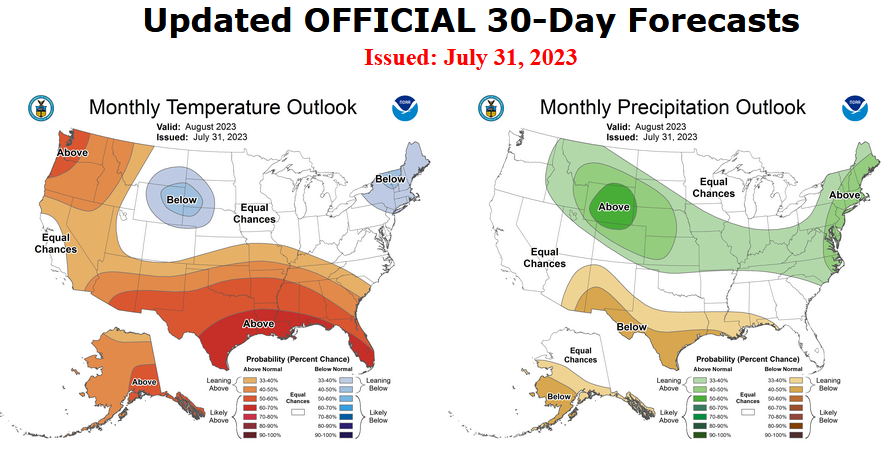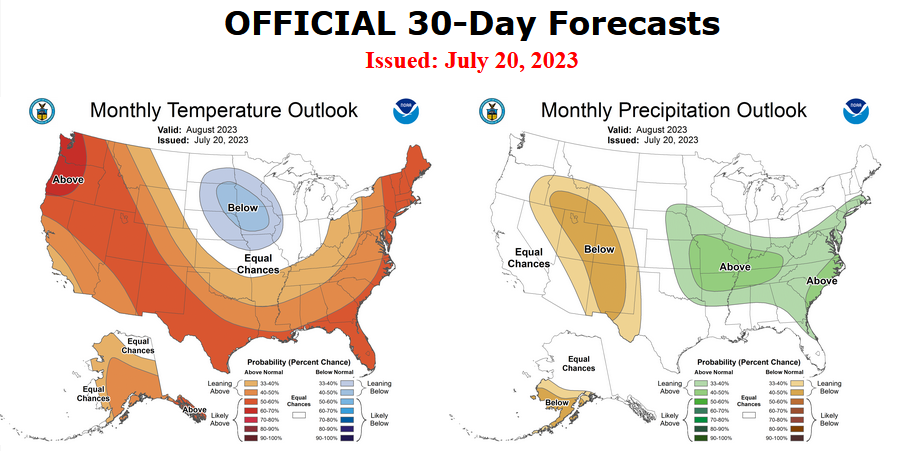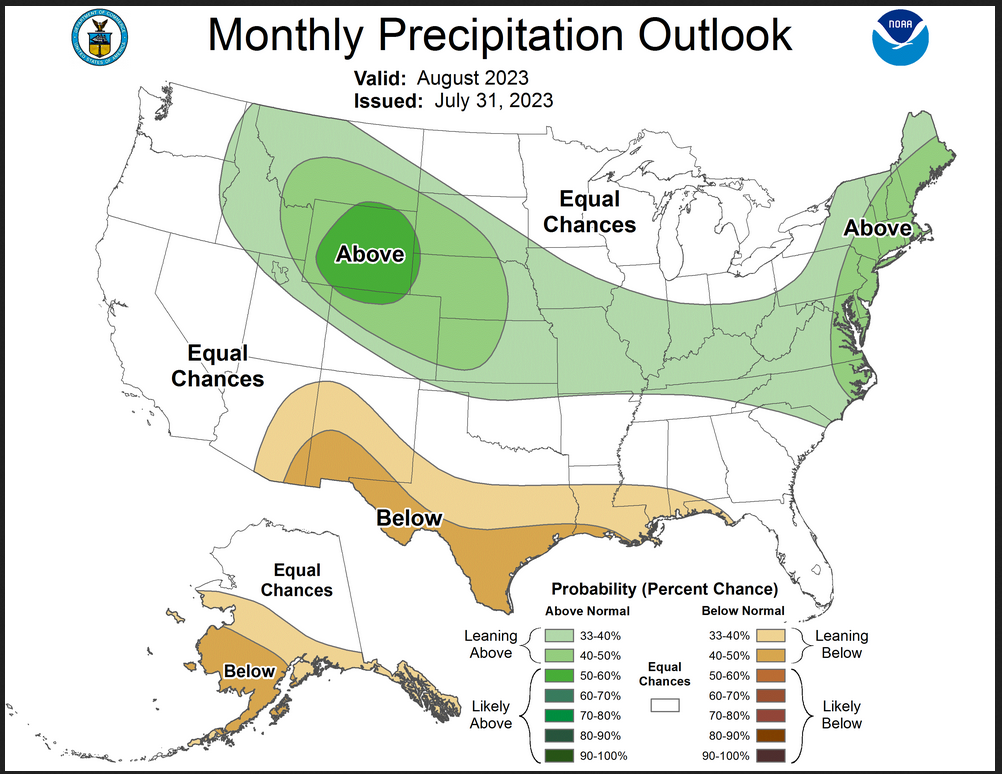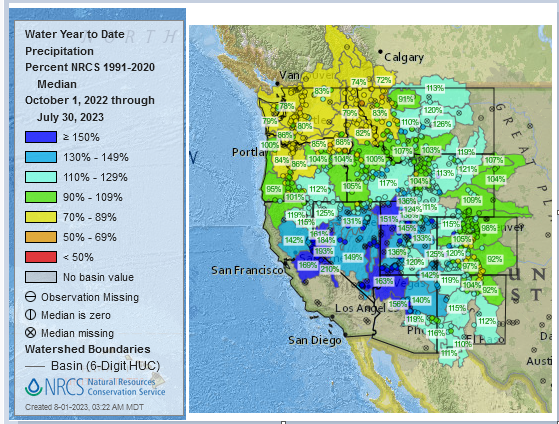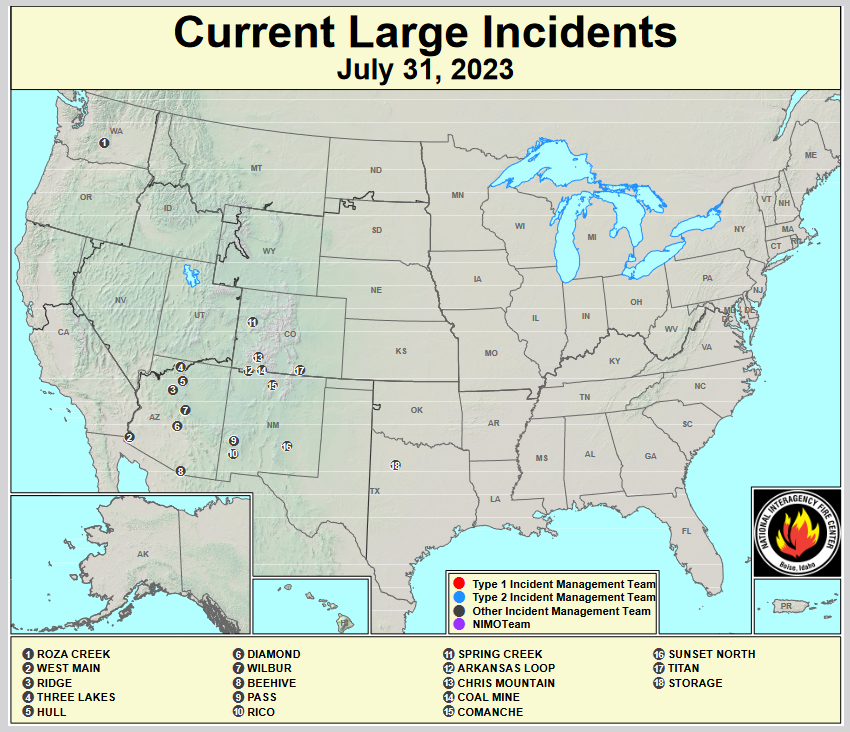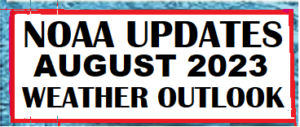
At the end of every month, NOAA updates its Outlook for the following month which in this case is August of 2023. We are reporting on that tonight.
There have been some changes in the Outlook for August but they are not dramatic and these are addressed in the NOAA Discussion so it is well worth reading. We provided the prior Mid-Month Outlook for August for comparison. It is easy to see the changes by comparing the Mid-Month and Updated Maps.
The article includes the Drought Outlook for August. NOAA also adjusted the previously issued Seasonal Drought Outlook to reflect the changes in the August Outlook. We have also included the current fire incidents and a map showing the water-year-to-date precipitation. We also provide the Week 2/3 Tropical Outlook for the World.
The best way to understand the updated outlook for August is to view the maps and read the NOAA discussion. But here are some of the highlights:
- El Niño conditions are present in observations of the equatorial Pacific atmospheric and ocean, and are likely to continue through the month of August and into later seasons.
- The updated August temperature outlook favors above normal temperatures across Alaska with more likely above normal temperatures for southeastern Alaska,
- Above normal temperatures continue to be favored for much of the West, as in the prior outlook. However, probabilities of above normal have decreased substantially across the Great Basin, and there are now equal chances (EC) of above, near or below normal temperatures for much of California,
- Below normal temperatures are favored for a small area of the northern High Plains,
- Probabilities of above normal temperatures are further enhanced from the Southern Plains into the Southeast,
- Average below normal temperatures are slightly favored for parts of the Northeast for the month of August,
- The updated August precipitation outlook favors below normal precipitation for southwestern areas of the Alaska Mainland eastward along the coast into southeast Alaska,
- Above normal precipitation is favored in a swath from the northern Rockies across parts of the High Plains, the Central Plains, and Ohio Valley,
- Above normal precipitation is likely for August, probabilities exceeding 50 percent, for a small area of the northern High Plains,
- Above normal precipitation is favored for the East Coast from parts of the Carolinas to New England, with much above average sea surface temperatures offshore and the influx of moisture.
- Below normal precipitation is favored from parts of the Southwest, the Rio Grande Valley, and the Gulf Coast, to the Florida Panhandle,
Here is the updated Outlook for August 2023
For Comparison Purposes, Here is the Mid-Month Outlook for August.
| There has been some change but not dramatic. Remember, it is the top set of maps that are the current outlook for August. |
Combination of the Updated Outlook for August and the Three-Month Outlook

| Not much difference between August and the three-month period that includes August. I am too tired to figure it out right now but there is some similarity between the one-month and three-month and the mid-month for August and the updated outlook for August. There is no reason for that but if I am not dreaming it there is some pattern there which I will look at again the next time I am coherent and have the time to do it. |
ANALYSIS
Notice that for both temperature and precipitation, the one-month Outlook and three-month Outlook are not similar. This suggests that the Outlook for the combined second and third months if shown would be different than either the Outlook for the First (next) Month or the Three-Month Outlook. The formula for calculating the combined second and third-month outlook is:
For both temperature and precipitation, if you assume the colors in the maps are assigned correctly, it is a simple algebra equation to solve the month two/three anomaly probability for a given location = (3XThree-Month Probability – Month One Probability)/2*. So you can derive the month two/three outlook this way. You can do that calculation easily for where you live or for the entire map.
It is important to remember that the Outlook for next month was updated on the last day of the current month and the three-month Outlook was issued on the third Thursday. So the period of time between the Mid-Month and End of Month Update varies from month to month from 10 days to 16 days. So there sometimes is a substantial change in the Next Month’s Outlook from the Mid-Month prediction. In such cases, we wonder if a change in the one-month outlook suggests that the three-month outlook would need to also be adjusted. This month I do not think that it is the case.
| Our regular Daily Weather article can be found HERE. In addition to the short-term forecast it also provides the 6 – 10 day, 8 – 14 day, and Week 3 – 4 Outlooks. That is not a full month but close to it. So it is helpful if one wants to understand how the full-month forecast is expected to vary through the month. And the maps in the Daily article update throughout the month. |
Here are larger versions of the Temperature and Precipitation Outlook maps.

NOAA (Really the National Weather Service Climate Prediction Division CPC) Discussion (I have shown certain important points in bold type. My comments if any are in brackets [ ])
30-DAY OUTLOOK DISCUSSION FOR AUGUST 2023
The Monthly Outlook for temperature and precipitation for August is updated using the latest temperature and precipitation outlooks for the first week of August from the Weather Prediction Center (WPC), the Climate Prediction Center (CPC) extended range forecasts for the 6-10 day and week-2 periods, the CPC Week 3-4 Outlook, as well as dynamical model forecasts from the CFSv2 and GEFS for the full month of August. El Niño conditions are present in observations of the equatorial Pacific atmospheric and ocean, and are likely to continue through the month of August and into later seasons. There is a weak Madden Julian Oscillation (MJO) as indicated by the velocity potential field. However, the Real-time Multivariate MJO (RMM) index is low in amplitude and model forecasts show only weak propagation of the signal across the western hemisphere. MJO is unlikely to impact the climate of North America for the month of August.
Temperature
The updated August temperature outlook favors above normal temperatures across Alaska with more likely above normal temperatures for southeastern Alaska, supported by dynamical model forecasts from the CFSv2 as well as CPC outlooks that favor above normal temperatures for the 6-10 day, week-2, and week 3-4 periods. Above normal temperatures continue to be favored for much of the West, as in the prior outlook. However, probabilities of above normal have decreased substantially across the Great Basin, and there are now equal chances (EC) of above, near or below normal temperatures for much of California, supported by dynamical model forecasts from the CFSv2, as well as the CPC Week-2 and Week 3-4 Outlooks. Below normal temperatures are favored for a small area of the northern High Plains, supported by the latest guidance from the CFSv2, as well as WPC outlooks for week 1 and the CPC week-2 temperature outlook. Probabilities of above normal temperatures are further enhanced from the Southern Plains into the Southeast, supported by the CFSv2 temperature forecasts, WPC outlooks for week 1, and CPC outlooks for week 2 and week 3-4. Average below normal temperatures are slightly favored for parts of the Northeast for the month of August, with predicted likely below normal temperatures for most of the first half of the month, when confidence is high, followed by a slightly enhanced probability of above normal temperatures for most of the Northeast in the Week 3-4 Outlook.
Precipitation
The updated August precipitation outlook favors below normal precipitation for southwestern areas of the Alaska Mainland eastward along the coast into southeast Alaska, supported by precipitation guidance for the month from the CFSv2. Above normal precipitation is favored in a swath from the northern Rockies across parts of the High Plains, the Central Plains, and Ohio Valley, supported by the latest CFSv2 model forecasts, as well as CPC outlooks for the 6-10 day and week-2 periods. Above normal precipitation is likely for August, probabilities exceeding 50 percent, for a small area of the northern High Plains, where WPC outlooks for week 1 indicate climatologically high precipitation amounts. Above normal precipitation is favored for the East Coast from parts of the Carolinas to New England, with much above average sea surface temperatures offshore and the influx of moisture. Below normal precipitation is favored from parts of the Southwest, the Rio Grande Valley, and the Gulf Coast, to the Florida Panhandle, supported primarily by CFSv2 model forecasts for the month.
Drought Outlook
Here is the newly issued Drought Outlook for next month.
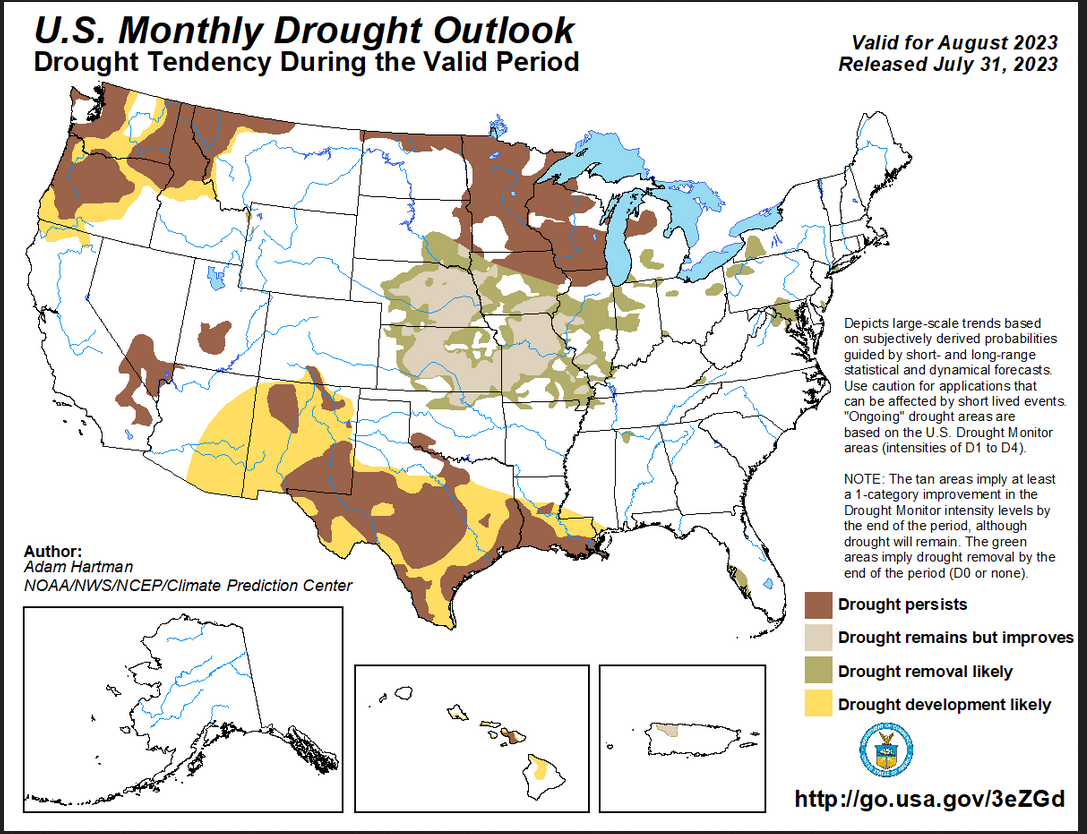
| You can see where drought development or reduction is likely. Overall the forecast is for the intensification of drought conditions but with some improvement in the corn and soybean belt. The summary and detailed discussions that accompany this graphic can be accessed HERE, but the short version is shown below. |
Here is the short version of the drought summary
Latest Monthly Assessment – Leading up to August, drought has slowly expanded across the Pacific Northwest due to below normal precipitation on the heels of a below average 2022-2023 winter wet season. Drought also developed across portions of the Midwest and Great Lakes during the months of May and June. Some of the drought across the Midwest also expanded into portions of the Ohio Valley and Northeast during that time, but several areas across the Midwest have seen improvements in recent weeks due to multiple periods of heavy rainfall. Long-term drought over the Great Plains has been slowly improving the past few months, particularly across parts of the Great Plains, where several locations have received in excess of 1.5 times their normal precipitation. Parts of the Intermountain West have continued to see slow improvements to drought conditions since the start of 2023, aided by above normal winter snowpack, sporadic convection, and above normal streamflows. However, the slow start to the North American Monsoon (NAM) season and recent excessive heat across parts of the western U.S. has resulted in topsoil moisture drying out, particularly across the Four Corners region. Fortunately, there are signs that the NAM has become more established in recent weeks.
During August, above normal temperatures are predominantly favored across the western U.S., leading to drought persistence for parts of the Pacific Northwest and Four Corners region, with the potential for additional drought development where August precipitation signals are weakest. Central portions of the Intermountain West may be spared degradation, as those areas are still showing benefits from periods of above normal rainfall during the last 60 to 90 days and enhanced chances of above normal precipitation are favored during August. Monthly temperature and precipitation outlooks, ENSO, and climatology favor widespread drought improvement and removal across the central U.S. However, drought persistence is favored in the Upper Midwest, although there is the potential for localized improvements. Extended-range and long-range temperature and precipitation outlooks favor drought development across parts of southern Texas and the Lower Mississippi Valley. Widespread drought improvement and removal are favored across the eastern third of the U.S., where short and long-range precipitation outlooks favor near to above normal precipitation and warm sea surface temperatures in the Gulf of Mexico and western Atlantic will act to enhance the potential for daytime thunderstorm activity.
Despite some abnormal dryness present at the start of August, Alaska is favored to remain drought-free, as August is typically a wet time of year. In Hawaii, although temperatures are forecast to remain cooler than average, precipitation is strongly favored to be below normal by the end of August, leading to drought persistence and the potential for additional development. In Puerto Rico, the potential for tropical activity and the favorable precipitation outlooks for August favor drought removal.
We also have an updated Seasonal Drought Outlook (link).

| It is not that much different than the single-month outlook but it covers a longer period of time. |
| To update this forecast (which updates on Tuesdays) click HERE |
Month-to-date Temperature as the current month evolves can be found at https://hprcc.unl.edu/products/maps/acis/MonthTDeptUS.png
Month-to-date Precipitation as the current month evolves can be found at https://hprcc.unl.edu/products/maps/acis/MonthPNormUS.png
CLIMAS Podcast
No Podcast this Month
Water-year-to-date precipitation. Here is the LINK
| This provides a very clear picture of the weather pattern since October 1, 2022. |
Fire Outlook
Updates to the major fire situation can be found by clicking here https://fsapps.n wcggov/afm/index.php
| The number of wildfires has increased slightly. This map does not include Canada where they are having a lot of problems with wildfires right now. |
| I hope you found this article interesting and useful |
